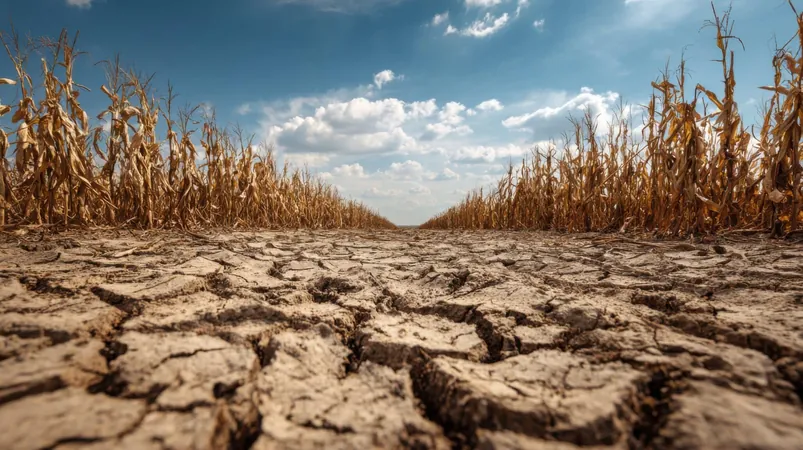
Plants Unleash Their Inner Heroes: How They Bounce Back After Drought
2025-09-16
Author: Noah
The Astonishing Resilience of Plants
Scientists at the Salk Institute have unveiled a groundbreaking discovery: plants have a remarkable ability to supercharge their immune responses after experiencing drought, revealing crucial genetic pathways for cultivating hardier crops.
A Surprising Recovery Strategy
When faced with drought, plants typically prioritize growth, relying on sunlight, nutrients, and water. However, after a drought ends and water becomes available again, plants don’t jump right back into growth mode—surprisingly, they shift their focus. Researchers found that rather than racing to grow, plants activate powerful immune responses.
The Science Behind the Recovery
Using cutting-edge single-cell and spatial transcriptomic techniques, biologists studied the model plant Arabidopsis thaliana as it rebounded from drought. Remarkably, they discovered an immediate surge in immune-boosting genes across the plant’s leaves—this phenomenon is known as Drought Recovery-Induced Immunity (DRII). This temporary immune surge seems essential for the plant’s recovery, providing vital protection during a vulnerable phase.
Evolutionary Significance of Drought Recovery
Importantly, DRII isn’t confined to the laboratory. The team observed a similar response in both wild and cultivated tomatoes, suggesting that this recovery mechanism is evolutionarily conserved and could potentially apply to other important crops. These findings open up avenues for genetically engineering plants that are not only drought-resistant but also better equipped to combat diseases in water-scarce environments.
A Window Into Plant Resilience
Published in *Nature Communications*, the study emphasizes how understanding the recovery phase after drought could be paramount in developing strategies to protect the global food supply. Senior author Joseph Ecker notes, "Drought poses a major challenge, but how plants recover remains underexplored. Our work highlights recovery as a critical period for genetic reprogramming, leading to innovative approaches in crop engineering."
Unveiling the Mysteries of Recovery
For decades, Arabidopsis thaliana has served as a key model for plant biology due to its rapid growth and straightforward genome, sharing many genetic traits with staples like tomatoes, wheat, and rice. During drought, Arabidopsis must balance between absorbing water through tiny leaf pores and protecting against pathogens.
Tracking Genetic Changes in Real Time
In an innovative approach, researchers rehydrated drought-stressed plants and scrutinized the genetic changes in their leaves within a mere 15 minutes, tracking shifts over time until 260 minutes post-watering. This rapid analysis is unmatched in plant biology, revealing vital genetic patterns that could otherwise go unnoticed.
Unleashing Drought Recovery-Induced Immunity
Just 15 minutes after rehydration, dormant genes in the leaves of Arabidopsis sprang to life, activating thousands of genes to mount a robust immune response known as Drought Recovery-Induced Immunity (DRII). This critical surge in immunity buys the plant time to recover and resume its growth,
Looking Ahead: The Future of Crop Resilience
With DRII detected in tomatoes as well, researchers are optimistic about its implications for various crop species. However, pivotal questions remain about how signals from rehydration communicate so rapidly with the plant’s immune response. This dynamic reprogramming during recovery phases challenges traditional perceptions of plant stress and survival, suggesting that plants are actively preparing for recovery rather than simply reacting to immediate threats.
As Joseph Ecker concludes, "Our findings demonstrate that drought recovery is not passive but a dynamic enhancement of the plant's immune system. By unraveling these quick genetic events, we can uncover the molecular signals directing stress recovery, paving the way for resilient crops".









 Brasil (PT)
Brasil (PT)
 Canada (EN)
Canada (EN)
 Chile (ES)
Chile (ES)
 Česko (CS)
Česko (CS)
 대한민국 (KO)
대한민국 (KO)
 España (ES)
España (ES)
 France (FR)
France (FR)
 Hong Kong (EN)
Hong Kong (EN)
 Italia (IT)
Italia (IT)
 日本 (JA)
日本 (JA)
 Magyarország (HU)
Magyarország (HU)
 Norge (NO)
Norge (NO)
 Polska (PL)
Polska (PL)
 Schweiz (DE)
Schweiz (DE)
 Singapore (EN)
Singapore (EN)
 Sverige (SV)
Sverige (SV)
 Suomi (FI)
Suomi (FI)
 Türkiye (TR)
Türkiye (TR)
 الإمارات العربية المتحدة (AR)
الإمارات العربية المتحدة (AR)